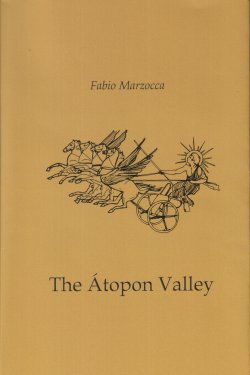The Átopon Valley
As the man continued to play,
Ughino’s eyes, turned eastwards, lit up:
he could see at the horizon a marvelous
gold chariot rising.
The chariot was drawn by four white horses.
Its light reflected throughout the valley.
The quadriga was led by a young man, who stood upright, holding the bridles of the steeds, while the morning sun was shining behind his head!
The child stood still, enchanted by that
image and by the sounds that were
surrounding him.
Buy the e-book on Amazon here
Synopsis
 Ughino, a very poor child who lives in a small town on the Umbrian hills near Orvieto, would give anything to see his ailing mother cured, but her illness “ can not be cured by medicine”, as the local women say. The child grows increasingly depressed.
Ughino, a very poor child who lives in a small town on the Umbrian hills near Orvieto, would give anything to see his ailing mother cured, but her illness “ can not be cured by medicine”, as the local women say. The child grows increasingly depressed.
In his never-ending search for a solution, a strange encounter indicates the direction of the course to be followed; therefore, Ughino asks his two best friends, Markus and Angela, to join him in a magical adventure, which will take them to visit a fantastic valley inhabited by unbelievable characters. It will be the very queen Arborea, the androgynous divinity, to suggest a solution to the children , a journey which will meander through the work of a modern shaman.
In the novel, the images of the most ancient mythology take shape in an environment which represents the reflection of the real world and which reveals itself through a universal symbolic language. Each live being in Àtopon has its own personal appendix (the “cocoon”) which is subjected to the influence of the myths, the preexisting forms of models of behavior of the human spirit.
The story develops as a fable, an imaginary adventure which narrates the events experienced by the three youngsters in a world, which appears more real through their imagination than through the foggy eyes of an adult.
(translated by Maria Burnett)
Buy the e-book on Amazon here.
Author's Note
I felt the need to write this short novel after having read numerous works, among which, the last in chronological order, “Field, Form and Fate” by Michael Conforti, an analyst, advocate of Carl Jung’s theories, from Brattleboro, Vermont. In his book, Dr. Conforti outlines the theory of the archetypical field, according to which, the fields influence individuals, the same way physical fields influence nature. “The fields can be considered,” writes the American analyst “the means by which archetypes become matter.” [1]

This is where the idea of the Valley comes from: a symbolic representation of a place without a place (an Átopon), abode of the whole psyches, where primordial images submit the deepest layers of each human being to the effect of their fields of influence.
In Átopon, every archetype has its keeper, the guardian of the field, usually a mythological figure. Myths are, first and foremost, public expressions that reveal the essence of the soul.[2] For this reason, they always speak about origin or at least of what is archetypal.[3] The myth, whatsoever its nature, is always a “precedent” and an “example”, not only with regards to the actions of men, but also its own condition.[4] The myths date back to an archaic storyteller and his dreams, to men moved by the sultry urge of their illusions. These men were not very different from the ones who, many generations later, were tagged as poets and scholars.[5]
Finally, the cocoon has been chosen as the figurative image of the “vital breath” of each human being, as in each individual form, it expresses the idea of a cocoon containing a treasured prize in need of a much needed sustaining blood: the embryo of life.
The Valley, therefore, is the no-place where the hidden part of each of us lives. There is not a direct communication with the Valley in the true sense of the word. The Valley is the no-place where the possibility of a meta-communication through dreams, instincts and perceptions is present. At best, one continues to dream of the myth, attributing a modern form to it. And when the talk is not clear or every contact with Átopon appears impossible, Queen Arborea steps in with her “lucenti”, characters that can evoke demons and blind instinctive forces, only to tame them and place them at the service of good.[6]
This is the setting of the story of Paola, a fragile creature, a castaway from the people of the village because of her own fears. Paola is the victim of a painful youth, based on her even more painful awareness of being an orphan, probably abandoned by her own parents. Alcohol alone can appease the poor woman, even though peace lasts for just a few moments. Only through alcohol, the monsters in her mind are assuaged. The monsters allow her to establish a dialog only with the tombstones in the cemetery, in her search for a completeness the world of the living cannot give her.
Approaching the deepest themes of the essence of being through the actions of three pre-adolescents (the “paides”, as defined by Draconis) is related to the theme of the child being the image of forgotten elements from our childhood. This represents the aspect of our “childhood” pre-cognitive of the collective soul and its “fantasies,” as the natural manifestations of the life of the subconscious.[7] It is not surprising that a child can understand the voice of a barn owl or believe in the transformation of a kitten into a Bengali tiger. A child’s imagination, totally unrestricted, is the pure expression of an uncontaminated being. This is what Arborea describes when she says: “When you are totally immersed in your world of play, only mindful of giving life to your emotions, you are listening to the voice of your cocoon”.
Arborea’s palace does not have any edges. Everything is rounded and enclosed by a circle, evocative of the idea of completeness of a mandala. The queen herself, in her androgynous entity, holds within herself an image that goes beyond the limitations of opposite sexes. The divine androgyny often present in many myths and beliefs has a theoretical, metaphysical value. It expresses the co-existence of the opposites, of cosmological principles within a deity.[8]
The “cure” ritual, as described by Draconis at the end of chapter 18, sums up in its wholeness the long process of the woman’s recognition. It defines the removal of her inner monsters and the achievement of a state of awareness and equilibrium. The modern shaman was only a mean, the necessary instrument needed to start and control the progress of the course, and to uncover the trapdoor of Paola’s “basement,” letting out the forces that had been living there.
In the epilogue, the children spot Helios among the clouds and Arborea in the figure of a woman at the market, quicky transformed into Draconis, as she turns the corner. Do these last events appear to invalidate the whole tale? Do the characters and the places not match up?
But myth has no place, and it is removed from time. “Before” and “after” do not exist in myth.
[1] Michael Conforti – Field, Form and Fate – Spring Journal Inc. (1999)
[2] C.G.Jung – Gli archetipi dell’inconscio collettivo – Ed. Bollati Boringhieri (1977)
[3] C.G.Jung e Kàroly Kerenyi – Prolegomeni allo studio scientifico della mitologia – Ed. Boringhieri (1972)
[4] Mircea Eliade – Trattato di storia delle religioni – Ed. Bollati Boringhieri (1999)
[5] C.G. Jung – L’uomo e i suoi simboli – Ed. TEA(1991)
[6] Giuseppe Lampis – Lettera a un amico psicologo – Quaderno di Átopon n.1/2006 – Mythos
[7] C.G. Jung e Karoly Kerenyi – work cited
[8] Mircea Eliade – work cited
